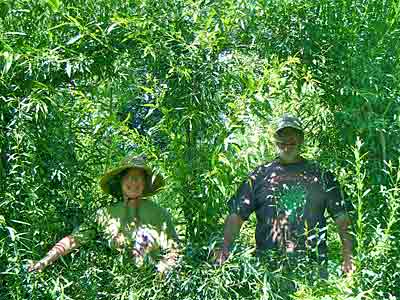 |
| Barbara Walch and Charlie Krause hold back new growth of basket willow to showcase the living fence. All photos by Holli Cederholm. |
By Holli Cederholm
Fire Flower Garden and Pottery is a cornerstone of MOFGA’s annual Common Ground Country Fair Farmers’ Market. Its array of MOFGA certified organic, dried and fresh flower bouquets, farm-harvested willow baskets, and inscribed pumpkins have long highlighted the harvest season for fairgoers perusing the Rose Gate market.
Barbara Walch, an accomplished potter, added a second career as a flower farmer after moving from Massachusetts to Thorndike, Maine, in 1989. “Essentially I had no intention of farming,” says Walch, who originally viewed her 10 acres as a place for her home, pottery studio and perennial garden.
However, within a few years Walch started attending the Belfast Farmers’ Market. Six years after relocating to Maine she met and married Charlie Krause, an artist who is also the Student Center manager and catering chef at nearby Unity College.
Walch’s original cultivated space, which included a wedding garden planted on a knoll behind their house, multiplied once Krause moved in.
“Things started to get bigger,” says Krause. He spends evenings and weekends in the gardens and would work up a new bed of his own, always leaving space for Walch to plant some of her surplus flowers. “We’ve expanded as far as we can physically,” he says.
The pair now manages 17 small plots of perennial and annual flowers, herbs, vegetables and small fruits laced throughout their property in a busy and beautiful pattern of production and self-sufficiency. Their garden space accounts for half an acre, and mown access areas add another quarter acre to their overall management. Most of the work is done by hand, with cultivation aided by two small walk-behind rototillers.
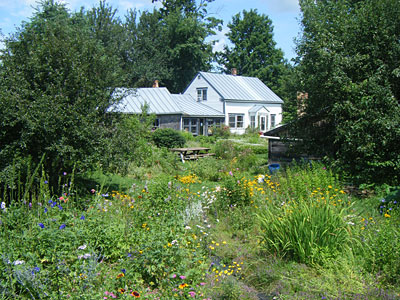 |
| Aptly named, Fire Flower’s pottery studio is housed inside the home, and Walch’s kiln sits among the flower beds. |
Creative Cultivation
Walch considers both aesthetics and production when planning her garden beds. “She has a passion for growing flowers,” says Krause – and it shows.
In a given season, one rectangular bed might herald straight rows of celosia – a favorite annual flower that Walch just couldn’t do without – next to beds of tomatoes and basil destined for their kitchen table. Another oblong space adjacent to her pottery kiln could bloom in a kaleidoscope of undelineated color – white yarrow and maroon rudbeckia mingling with a dozen other hues of wildflowers and perennial or annual cultivars.
Walch credits her flower fancy to a farm stand in Massachusetts that she encountered in the late ’70s. The stand sold driftwood from a local river, pumpkins and dried flowers. She would buy the flowers and display them in her jointly run pottery gallery. “It was just inspirational,” she says. “That was the beginning, the seed.”
From there she started experimenting with different flowers, growing them in a small garden at her studio. She also praises the stand for teaching her which flowers would dry well. “I learned the flowers from going and looking at that farm stand.”
After moving to Maine, the transition to work in flower production alongside her hand-built pottery was easy, says Walch. “Because I was a potter and made things and sold them, it seemed natural to grow things to sell.”
While she gave up her gallery shop with her move to Maine, Walch has continued to produce stoneware and dinnerware in organic shapes and colors inspired by nature over the last 40 years.
Krause’s own artistic impulses also riff on the Massachusetts farm stand. “Charlie’s thing is pumpkins,” says Walch.
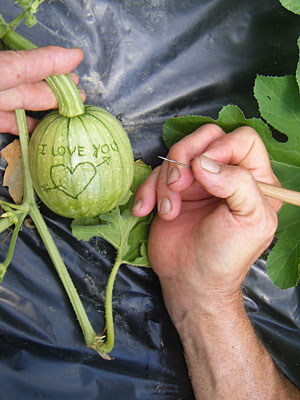 |
| Krause inscribes a young pumpkin by gently scratching away its tender skin. The message will heal over and grow with the fruit. |
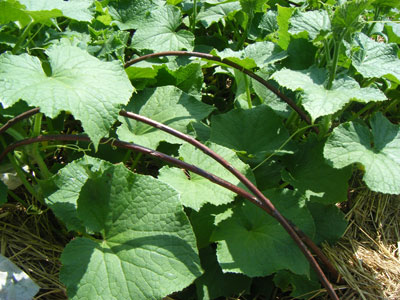 |
| Krause loves basket willow, using it as hoops to support row covers, living fences and, of course, baskets. |
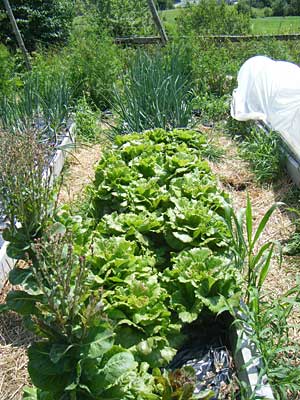 |
| Krause is always innovating in the garden. His latest attempt to reduce weeding: raised beds consisting of a 2- x 6-foot frame and black plastic mulch held down with 2 x 4s. Planted here are onions, leeks, head lettuce and a lettuce seed crop. |
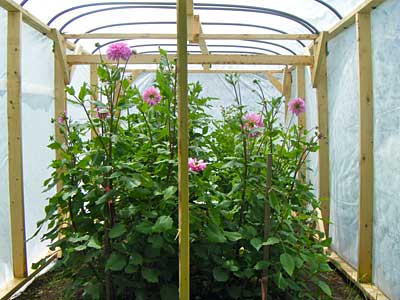 |
| Krause constructed this dahlia house to protect blooms from Japanese beetles, tarnished plant bugs and earwigs. The 6-foot-tall, 8-foot-wide, 16-foot-long wooden frame is covered in medium weight Agribon. |
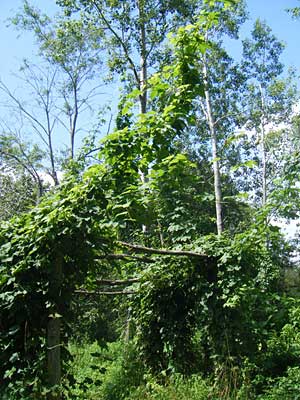 |
| Krause cultivates hops to make wreaths. Twine lines strung on nearby trees allow the plants additional vertical growth. |
Pumpkin vines sprawl throughout the cottage-garden-style landscape in a gradient of sizes. A special plot is reserved for a giant pumpkin, for which Krause sources pedigreed seed. Other patches proliferate a jungle of intertwined varieties, including ‘Spooky’ and ‘Baby Pam.’ These smaller cultivars Krause inscribes with commissioned designs, such as pirate ships, or whatever else strikes his imagination. Some returning favorites are: “I love you” and “Marry me.”
“You gotta get the pumpkin when it’s really young,” says Krause. He lies on the ground amid the plants, freehand drawing or scratching his images and phrases into the tender green pumpkin skin with a sewing needle inserted into a wooden handle. “The funny thing is, you never know how big the pumpkin is going to get,” he says.
Krause’s other garden contributions are further characterized by artistic whimsy. Along with grapes, raspberries and vegetables grown for home enjoyment and processing, Krause cultivates hops to make into wreaths. He gives the ripe cones that fall from the vines to local brewers in exchange for a taste of their finished product.
Willow Innovations
Krause’s work with willow is functional as well as creative. Among his specialties are his homegrown willow baskets, which Krause and Walch sell and use for their own harvest needs.
Krause used to have a wholesale basket-making business in which he used reeds imported from China. “I realized they were probably soaking them in chemicals to make them all white and perfect,” he says.
He didn’t like supporting this non-sustainable practice and consequently stopped his own production. Then his sister returned from California with a new basket material muse: the highly ornamental and non-spreading basket willow.
“You just stick the cuttings in the ground and you get another plant,” says Krause. The result is 6 to 8 feet of growth in a year, which should be harvested annually to prevent tree-size growth.
Krause has also woven the basket willow into two living fences – one creating dappled light for a shade garden, the other as a boundary between the neighboring property.
He used to build twig fences, which would naturally break down every few years. For the shade garden he planted the basket willow close to an existing twig fence, using it as the initial frame. Each year he snips off the smaller willow branches and weaves the larger branches into the fence. Now the fence grows stronger with time, rather than always requiring replacement.
Krause harvests the willow from his border fence in the winter, when “there’s nothing else to do,” and weaves the unpeeled green branches into rustic, washable, useable baskets. “I like putting together a basket and knowing it’s going to get used,” he says.
Garden Rhythm
Like most farms, work at Fire Flower extends into winter. Making art – whether pottery or baskets – and garden planning occupy the bulk of the off-season. Early spring initiates with seeding, followed by transplanting.
Walch begins selling both cut flower bouquets and perennial potted plants, which are divided annually each spring, in the beginning of May at the Belfast Farmers’ Market. She also sells perennials directly from the farm at 33 Knox Station Road in Thorndike.
“I would start with very few bouquets,” says Walch. For early bunching she relies on flowers from late bulbs, such as narcissus and tulips. She also staggers plantings of trialed and approved annuals, such as larkspur as early filler and dahlias as a later show-stopping centerpiece.
As the season slides into midsummer, Walch’s bouquet production increases as her annual flowers really start to bear. Around this time she starts harvesting select flower varieties for drying. She checks the blooms at least every other day, or else they may go by. “I have to catch them at the right time,” says Walch.
Post picking, she bundles the flowers and hangs them in her living room to dry. Walch also dries herbs in this fashion. Once the ceiling is full, she removes the dried flowers and packs them into boxes. These are destined for bouquets to be made later and sold primarily at the Fair. “People are not interested in dried flowers until fall … As long as there’s fresh flowers, that’s what they want,” she says.
Walch also makes pots daily, alternating time between her in-house studio and the gardens hemming her dooryard. “Gardens won’t wait,” she says, “but neither will the summer visitors to Maine.”
She fires her kiln eight times throughout the year. The finished pieces are sold mostly in Maine, with a large portion displayed at a pottery cooperative, The Maine Potters Market, in the Old Port in Portland, where she is one of 13 owner-members.
Walch used to sell her pottery in the artisan crafts area of the Common Ground Country Fair – her involvement dating back to MOFGA’s Windsor location. Following the Fair’s relocation to Unity, Walch’s pottery sales declined, and she and Krause decided to switch to vending in the farmers’ market. Walch and Krause enjoyed that market so much that they’ve been participating ever since.
A lot of their season’s efforts culminate in their display at the Fair, in which they really take pride. Sweet Annie bunches scent Krause’s home-constructed wood and canvas canopy. Shelf space is occupied by pumpkins inscribed in summer, now healed over and grown to full size. Hand-sculpted vases exhibit the season’s waning bounty, once-ephemeral flowers now frozen in time – for a while, anyhow.
“We really feel like part of something,” says Walch.
Fire Flower Garden and Pottery will be vending at the Common Ground Country Fair’s Rose Gate Farmers’ Market on Friday, September 20, and Saturday, September 21. For more information, see www.barbarawalchpottery.com/ or https://www.facebook.com/barbara.walch.3.
